TOYOTA T100 1998 Manual PDF
Manufacturer: TOYOTA, Model Year: 1998, Model line: T100, Model: TOYOTA T100 1998Pages: 214, PDF Size: 4.72 MB
Page 71 of 214
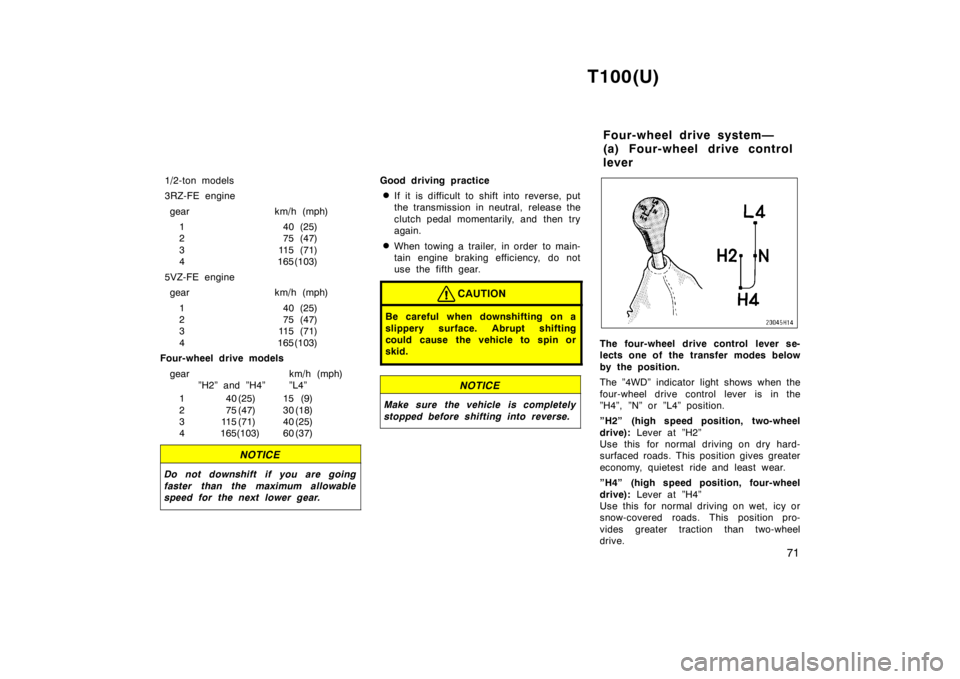
T100(U)71
1/2-ton models
3RZ-FE engine
gear km/h (mph) 1 40 (25)
2 75 (47)
3 115 (71)
4 165(103)
5VZ-FE engine gear km/h (mph)
1 40 (25)
2 75 (47)
3 115 (71)
4 165(103)
Four-wheel drive models
gear km/h (mph) ”H2” and ”H4” ”L4”
1 40 (25) 15 (9)
2 75 (47) 30 (18)
3 115 (71) 40 (25)
4 165(103) 60 (37)
NOTICE
Do not downshift if you are going
faster than the maximum allowable
speed for the next lower gear.
Good driving practice
� If it is difficult to shift into reverse, put
the transmission in neutral, release the
clutch pedal momentarily, and then try
again.
� When towing a trailer, in order to main-
tain engine braking efficiency, do not
use the fifth gear.
CAUTION
Be careful when downshifting on a
slippery surface. Abrupt shifting
could cause the vehicle to spin or
skid.
NOTICE
Make sure the vehicle is completely
stopped before shifting into reverse.
The four-wheel drive control lever se-
lects one of the transfer modes below
by the position.
The ”4WD” indicator light shows when the
four-wheel drive control lever is in the
”H4”, ”N” or ”L4” position.
”H2” (high speed position, two-wheel
drive): Lever at ”H2”
Use this for normal driving on dry hard-
surfaced roads. This position gives greater
economy, quietest ride and least wear.
”H4” (high speed position, four-wheel
drive): Lever at ”H4”
Use this for normal driving on wet, icy or
snow-covered roads. This position pro-
vides greater traction than two-wheel
drive. Four-wheel drive system—
(a) Four-wheel drive controllever
Page 72 of 214

T100(U)
72
”N” (neutral position):
Lever at ”N”
No power is delivered to the wheels. The
vehicle must be stopped.
”L4” (low speed position, four-wheel
drive): Lever at ”L4”
Use this for maximum power and traction.
Use ”L4” for climbing or descending steep
hills, off-road driving, and hard pulling in
sand, mud or deep snow.
See ”(c) Shifting procedure” for further
instructions.
The A.D.D. can be engaged or disen-
gaged by the shifting operations de-
scribed in ”(c) Shifting procedure”.
You should drive in four-wheel drive for at
least 16 km (10 miles) each month. This
will assure that the front drive components
are lubricated.
(b) A.D.D. (automatic
disconnecting differential)
Page 73 of 214
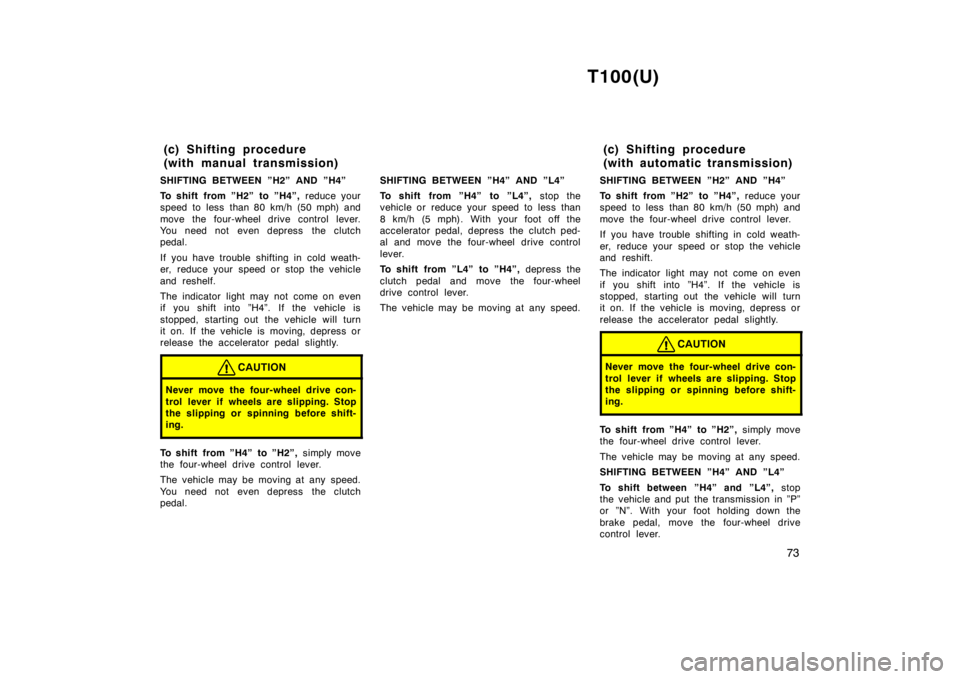
T100(U)73
SHIFTING BETWEEN ”H2” AND ”H4”
To shift from ”H2” to ”H4”,
reduce your
speed to less than 80 km/h (50 mph) and
move the four-wheel drive control lever.
You need not even depress the clutch
pedal.
If you have trouble shifting in cold weath-
er, reduce your speed or stop the vehicle
and reshelf.
The indicator light may not come on even
if you shift into ”H4”. If the vehicle is
stopped, starting out the vehicle will turn
it on. If the vehicle is moving, depress or
release the accelerator pedal slightly.
CAUTION
Never move the four-wheel drive con-
trol lever if wheels are slipping. Stop
the slipping or spinning before shift-
ing.
To shift from ”H4” to ”H2”, simply move
the four-wheel drive control lever.
The vehicle may be moving at any speed.
You need not even depress the clutch
pedal. SHIFTING BETWEEN ”H4” AND ”L4”
To shift from ”H4” to ”L4”,
stop the
vehicle or reduce your speed to less than
8 km/h (5 mph). With your foot off the
accelerator pedal, depress the clutch ped-
al and move the four-wheel drive control
lever.
To shift from ”L4” to ”H4”, depress the
clutch pedal and move the four-wheel
drive control lever.
The vehicle may be moving at any speed. SHIFTING BETWEEN ”H2” AND ”H4”
To shift from ”H2” to ”H4”,
reduce your
speed to less than 80 km/h (50 mph) and
move the four-wheel drive control lever.
If you have trouble shifting in cold weath-
er, reduce your speed or stop the vehicle
and reshift.
The indicator light may not come on even
if you shift into ”H4”. If the vehicle is
stopped, starting out the vehicle will turn
it on. If the vehicle is moving, depress or
release the accelerator pedal slightly.
CAUTION
Never move the four-wheel drive con-
trol lever if wheels are slipping. Stop
the slipping or spinning before shift-
ing.
To shift from ”H4” to ”H2”, simply move
the four-wheel drive control lever.
The vehicle may be moving at any speed.
SHIFTING BETWEEN ”H4” AND ”L4”
To shift between ”H4” and ”L4”, stop
the vehicle and put the transmission in ”P”
or ”N”. With your foot holding down the
brake pedal, move the four-wheel drive
control lever.
(c) Shifting procedure
(with manual transmission)
(c) Shifting procedure
(with automatic transmission)
Page 74 of 214
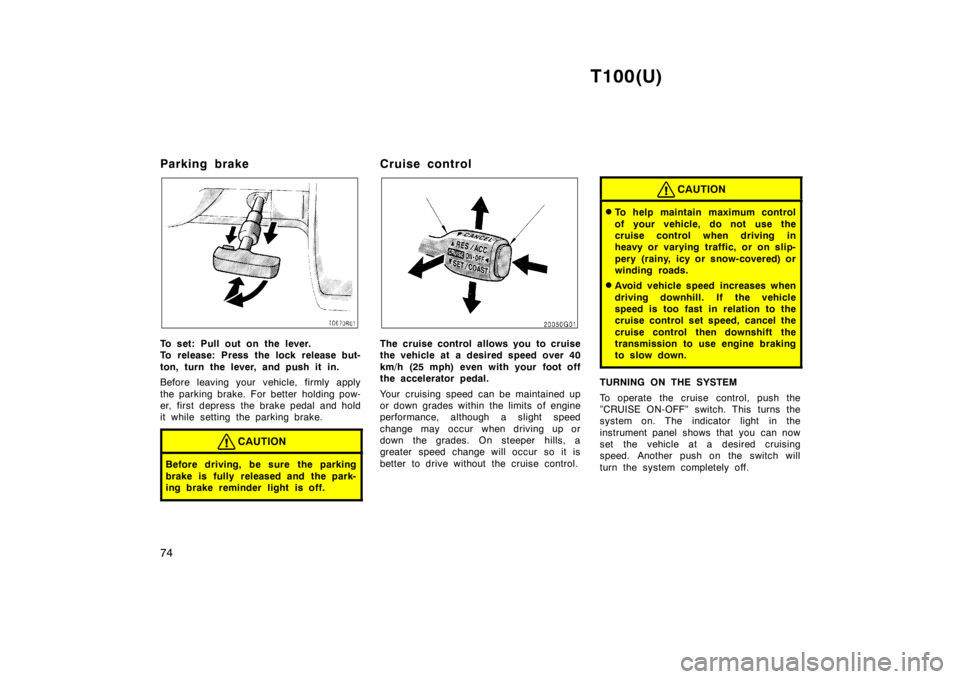
T100(U)
74
Parking brake
To set: Pull out on the lever.
To release: Press the lock release but-
ton, turn the lever, and push it in.
Before leaving your vehicle, firmly apply
the parking brake. For better holding pow-
er, first depress the brake pedal and hold
it while setting the parking brake.
CAUTION
Before driving, be sure the parking
brake is fully released and the park-
ing brake reminder light is off.
Cruise control
The cruise control allows you to cruise
the vehicle at a desired speed over 40
km/h (25 mph) even with your foot off
the accelerator pedal.
Your cruising speed can be maintained up
or down grades within the limits of engine
performance, although a slight speed
change may occur when driving up or
down the grades. On steeper hills, a
greater speed change will occur so it is
better to drive without the cruise control.
CAUTION
�
To help maintain maximum control
of your vehicle, do not use the
cruise control when driving in
heavy or varying traffic, or on slip-
pery (rainy, icy or snow-covered) or
winding roads.
� Avoid vehicle speed increases when
driving downhill. If the vehicle
speed is too fast in relation to the
cruise control set speed, cancel the
cruise control then downshift the
transmission to use engine braking
to slow down.
TURNING ON THE SYSTEM
To operate the cruise control, push the
”CRUISE ON-OFF” switch. This turns the
system on. The indicator light in the
instrument panel shows that you can now
set the vehicle at a desired cruising
speed. Another push on the switch will
turn the system completely off.
Page 75 of 214
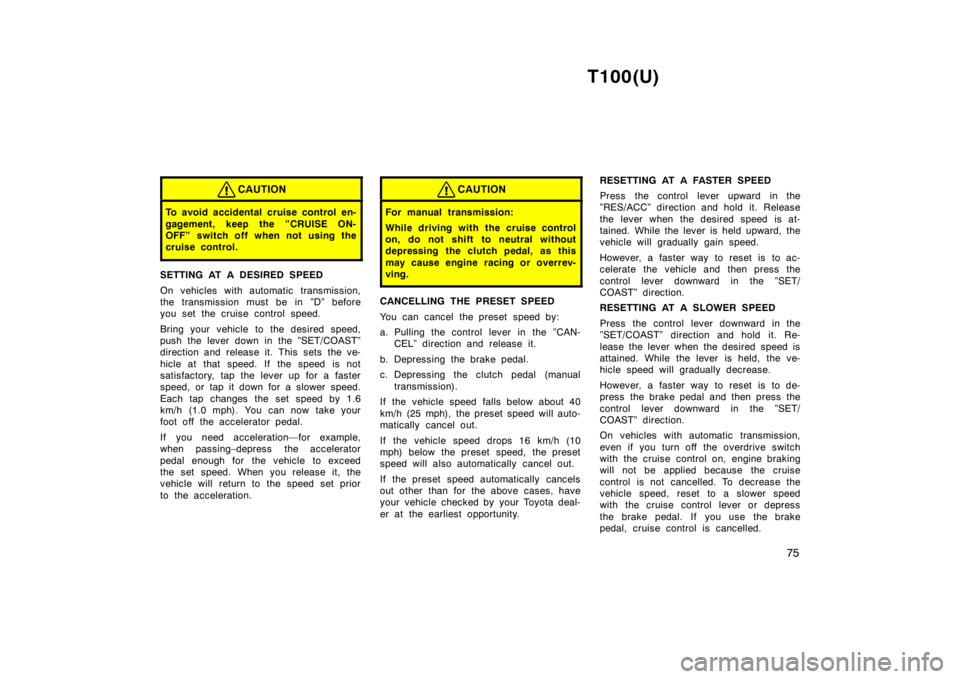
T100(U)75
CAUTION
To avoid accidental cruise control en-
gagement, keep the ”CRUISE ON-
OFF” switch off when not using the
cruise control.
SETTING AT A DESIRED SPEED
On vehicles with automatic transmission,
the transmission must be in ”D” before
you set the cruise control speed.
Bring your vehicle to the desired speed,
push the lever down in the ”SET/COAST”
direction and release it. This sets the ve-
hicle at that speed. If the speed is not
satisfactory, tap the lever up for a faster
speed, or tap it down for a slower speed.
Each tap changes the set speed by 1.6
km/h (1.0 mph). You can now take your
foot off the accelerator pedal.
If you need acceleration—for example,
when passing–depress the accelerator
pedal enough for the vehicle to exceed
the set speed. When you release it, the
vehicle will return to the speed set prior
to the acceleration.
CAUTION
For manual transmission:
While driving with the cruise control
on, do not shift to neutral without
depressing the clutch pedal, as this
may cause engine racing or overrev-
ving.
CANCELLING THE PRESET SPEED
You can cancel the preset speed by:
a. Pulling the control lever in the ”CAN-CEL” direction and release it.
b. Depressing the brake pedal.
c. Depressing the clutch pedal (manual transmission).
If the vehicle speed falls below about 40
km/h (25 mph), the preset speed will auto-
matically cancel out.
If the vehicle speed drops 16 km/h (10
mph) below the preset speed, the preset
speed will also automatically cancel out.
If the preset speed automatically cancels
out other than for the above cases, have
your vehicle checked by your Toyota deal-
er at the earliest opportunity. RESETTING AT A FASTER SPEED
Press the control lever upward in the
”RES/ACC” direction and hold it. Release
the lever when the desired speed is at-
tained. While the lever is held upward, the
vehicle will gradually gain speed.
However, a faster way to reset is to ac-
celerate the vehicle and then press the
control lever downward in the ”SET/
COAST” direction.
RESETTING AT A SLOWER SPEED
Press the control lever downward in the
”SET/COAST” direction and hold it. Re-
lease the lever when the desired speed is
attained. While the lever is held, the ve-
hicle speed will gradually decrease.
However, a faster way to reset is to de-
press the brake pedal and then press the
control lever downward in the ”SET/
COAST” direction.
On vehicles with automatic transmission,
even if you turn off the overdrive switch
with the cruise control on, engine braking
will not be applied because the cruise
control is not cancelled. To decrease the
vehicle speed, reset to a slower speed
with the cruise control lever or depress
the brake pedal. If you use the brake
pedal, cruise control is cancelled.
Page 76 of 214

T100(U)
76
RESUMING THE PRESET SPEED
If the preset speed is cancelled by pulling
the control lever or by depressing the
brake pedal or clutch pedal, pushing the
lever up in the ”RES/ACC” direction will
restore the speed set prior to cancellation.
However, once the vehicle speed falls be-
low about 40 km/h (25 mph), the preset
speed will not be resumed.
CRUISE CONTROL FAILURE WARNING
If the ”CRUISE” indicator light in the
instrument cluster flashes when using the
cruise control, there is some trouble in the
cruise control system. Contact your Toyota
dealer and have your vehicle inspected.
To crank the engine without depressing
the clutch pedal, push the switch with
the ignition on.
The switch stays on as long as the igni-
tion is on. And it will automatically turn off
when the ignition is off.
This switch cancels the clutch start sys-
tem, which is designed to keep the starter
motor from operating if the clutch pedal is
not depressed all the way down.
The switch allows the vehicle to be driven
out of difficult situations by cranking the
engine with the clutch engaged.
Never use the switch for normal engine
starting. Be sure to follow the starting
procedure instructed in ”How to start the
engine” in Part 3.
Clutch start cancel switch
(four-wheel drive models
with manual transmission)
Page 77 of 214
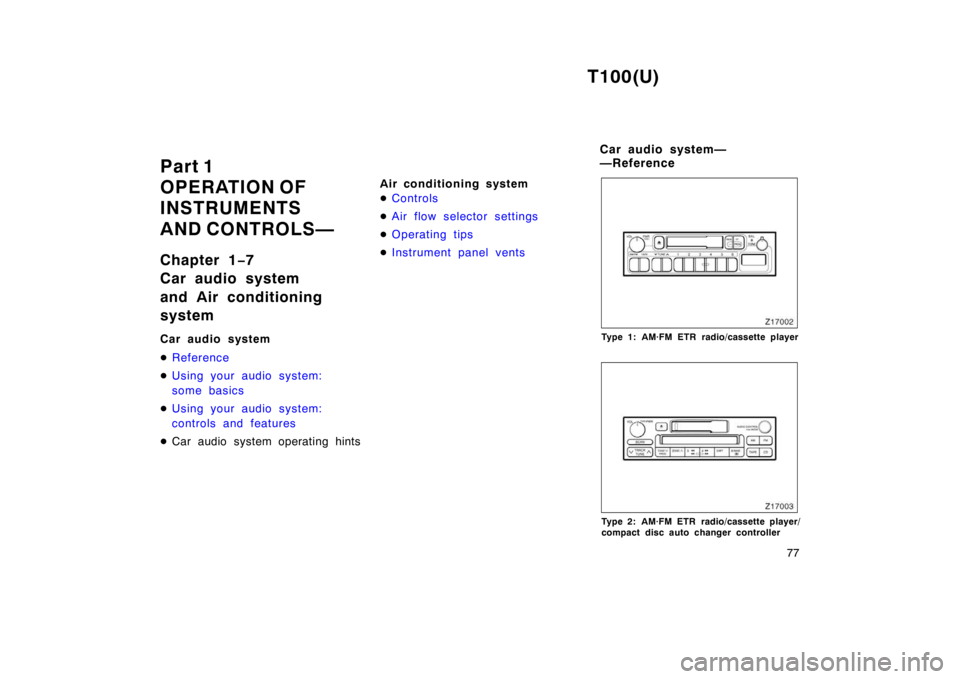
T100(U)77
Part 1
OPERATION OF
INSTRUMENTS
AND CONTROLS—
Chapter 1
−7
Car audio system
and Air conditioning system
Car audio system �
Reference
�Using your audio system:
some basics
�Using your audio system:
controls and features
� Car audio system operating hints Air conditioning system �
Controls
�Air flow selector settings
�Operating tips
�Instrument panel vents
Z17002
Type 1: AM·FM ETR radio/cassette player
Z17003
Type 2: AM·FM ETR radio/cassette player/
compact disc auto changer controller
Car audio system—
—Reference
Page 78 of 214
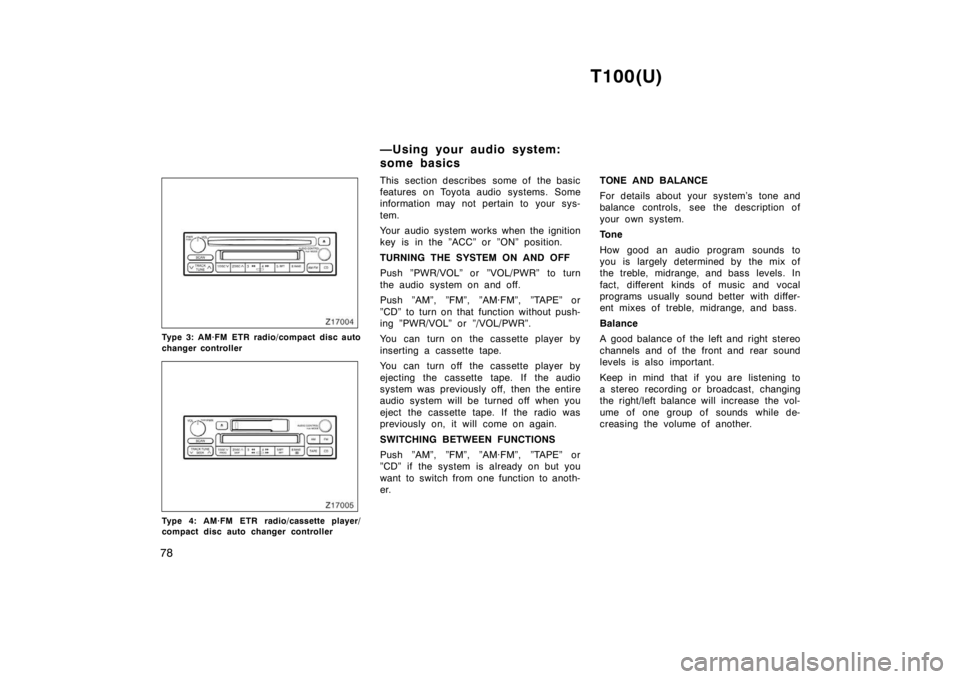
T100(U)
78
Z17004
Type 3: AM·FM ETR radio/compact disc auto
changer controller
Z17005
Type 4: AM·FM ETR radio/cassette player/
compact disc auto changer controller This section describes some of the basic
features on Toyota audio systems. Some
information may not pertain to your sys-
tem.
Your audio system works when the ignition
key is in the ”ACC” or ”ON” position.
TURNING THE SYSTEM ON AND OFF
Push ”PWR/VOL” or ”VOL/PWR” to turn
the audio system on and off.
Push ”AM”, ”FM”, ”AM·FM”, ”TAPE” or
”CD” to turn on that function without push-
ing ”PWR/VOL” or ”/VOL/PWR”.
You can turn on the cassette player by
inserting a cassette tape.
You can turn off the cassette player by
ejecting the cassette tape. If the audio
system was previously off, then the entire
audio system will be turned off when you
eject the cassette tape. If the radio was
previously on, it will come on again.
SWITCHING BETWEEN FUNCTIONS
Push ”AM”, ”FM”, ”AM·FM”, ”TAPE” or
”CD” if the system is already on but you
want to switch from one function to anoth-
er.
TONE AND BALANCE
For details about your system’s tone and
balance controls, see the description of
your own system.
Tone
How good an audio program sounds to
you is largely determined by the mix of
the treble, midrange, and bass levels. In
fact, different kinds of music and vocal
programs usually sound better with differ-
ent mixes of treble, midrange, and bass.
Balance
A good balance of the left and right stereo
channels and of the front and rear sound
levels is also important.
Keep in mind that if you are listening to
a stereo recording or broadcast, changing
the right/left balance will increase the vol-
ume of one group of sounds while de-
creasing the volume of another.
—Using your audio system:
some basics
Page 79 of 214
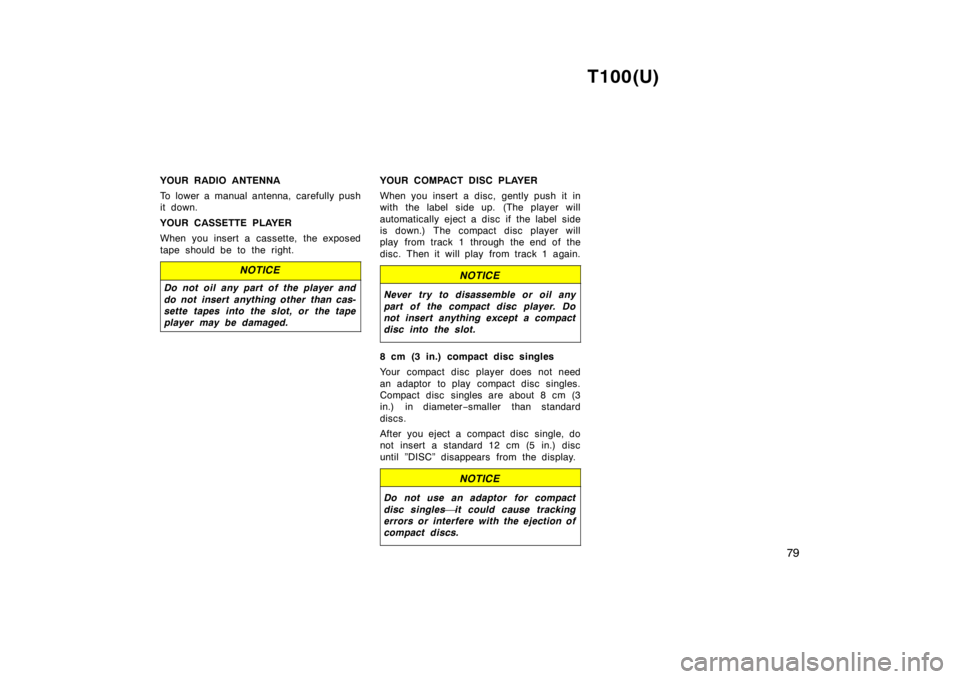
T100(U)79
YOUR RADIO ANTENNA
To lower a manual antenna, carefully push
it down.
YOUR CASSETTE PLAYER
When you insert a cassette, the exposed
tape should be to the right.
NOTICE
Do not oil any part of the player and
do not insert anything other than cas-
sette tapes into the slot, or the tape
player may be damaged.
YOUR COMPACT DISC PLAYER
When you insert a disc, gently push it in
with the label side up. (The player will
automatically eject a disc if the label side
is down.) The compact disc player will
play from track 1 through the end of the
disc. Then it will play from track 1 again.
NOTICE
Never try to disassemble or oil any
part of the compact disc player. Do
not insert anything except a compact
disc into the slot.
8 cm (3 in.) compact disc singles
Your compact disc player does not need
an adaptor to play compact disc singles.
Compact disc singles are about 8 cm (3
in.) in diameter
−smaller than standard
discs.
After you eject a compact disc single, do
not insert a standard 12 cm (5 in.) disc
until ”DISC” disappears from the display.
NOTICE
Do not use an adaptor for compact
disc singles �it could cause tracking
errors or interfere with the ejection of
compact discs.
Page 80 of 214

T100(U)
80 Details of specific buttons, controls, and
features are described in the alphabetical
listing that follows.
—Using your audio system:
controls and features �
Ty p e 1